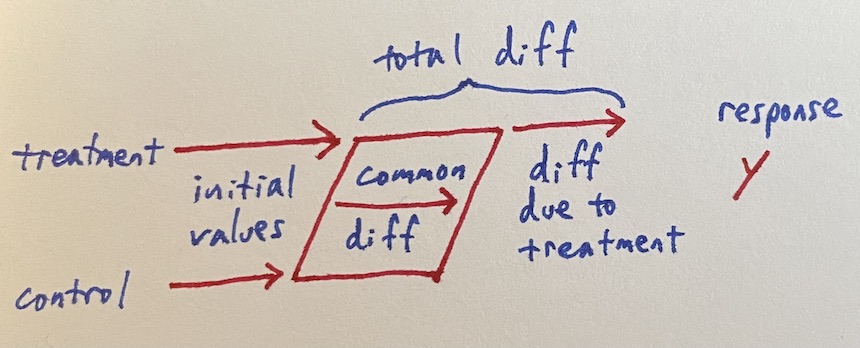Simple diff-in-diff
Sunday October 31, 2021
Things are always changing. Difference in differences tries to identify how much of a change is due to some treatment by comparing to a control that's also changing over time.

This is often presented graphically with response value against time.

A noiseless design matrix illustrates how this becomes a diff-in-diff regression.
| treatment base | control base | common diff | treatment diff | response |
|----------------|--------------|-------------|----------------|----------|
| 1 | 0 | 0 | 0 | 3 |
| 0 | 1 | 0 | 0 | 2 |
| 1 | 0 | 1 | 1 | 12 |
| 0 | 1 | 1 | 0 | 7 |
Real data will have noise; here's a simulation in R.
treatment_base = c(rep(1, 100), rep(0, 100), rep(1, 100), rep(0, 100))
control_base = c(rep(0, 100), rep(1, 100), rep(0, 100), rep(1, 100))
common_diff = c(rep(0, 100), rep(0, 100), rep(1, 100), rep(1, 100))
treatment_diff = c(rep(0, 100), rep(0, 100), rep(1, 100), rep(0, 100))
response = c(rnorm(100, mean=3),
rnorm(100, mean=2),
rnorm(100, mean=3) + rnorm(100, mean=5) + rnorm(100, mean=4),
rnorm(100, mean=2) + rnorm(100, mean=5))
summary(lm(response ~ treatment_base + control_base + common_diff + treatment_diff + 0))
## Estimate Std. Error t value Pr(>|t|)
## treatment_base 3.0747 0.1367 22.50 <2e-16 ***
## control_base 1.9798 0.1367 14.49 <2e-16 ***
## common_diff 5.0990 0.1933 26.38 <2e-16 ***
## treatment_diff 3.9453 0.2733 14.44 <2e-16 ***Diff-in-diff can get more complicated, but the simple version isn't too bad.
Thanks to Dr. Erica Blom for valuable discussion and references on this topic.
See also
- Four “back door” regression situations: What should be in your regression?
- Simple Front Door Regression
- A simple Instrumental Variable